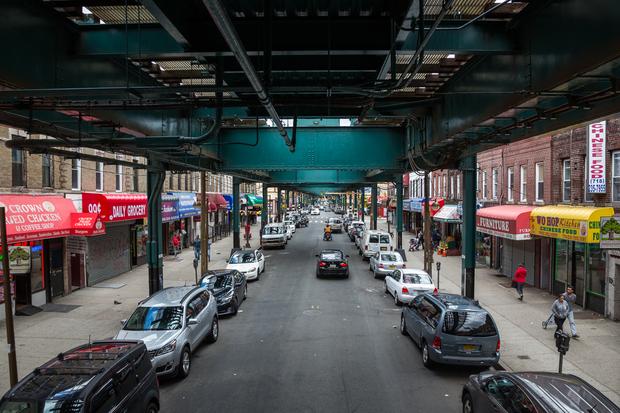
The de Blasio Administration has named East New York as the first of at least 15 communities in the city that will be rezoned in an effort to spur development and create more affordable housing.
The neighborhood, on the edge of Brooklyn where it meets up with Queens, has slogged through decades of disinvestment. Its population plummeted in the 1970s.
People left amidst a rampant crack cocaine and heroin epidemic that fueled violent crime. Whole blocks emptied out. But signs of recovery are starting to show up, especially on Fulton Street and surrounding blocks. Beneath the overhead subway lines, residents now jostle for snacks at busy bodegas and browse dollar stores for deals.
The Department of City Planning released its rezoning proposal in February. The goal is to create opportunities for new residential development, much of it permanent affordable housing. But local community organizations and residents fear the rezoning will fail to create enough housing and enough that is affordable for the current residents.
"The city has to change its approach to planning and stop tying it to zoning," said Tom Angotti, professor of urban affairs and planning at Hunter College. "They’re in the nasty habit of rezoning to encourage new development, and rezoning to preserve areas that are more privileged and areas that have political influence and power."
On Tuesday, hundreds of activists and residents gathered in Highland Park to demand a more just rezoning process.
"A lot of the new units that are going to be developed are going to be out-priced [for] median income for a resident of East New York," said Bill Wilkins, executive director of the Local Development Corporation of East New York.
Census data for the proposed area to be rezoned shows it is poorer, has a larger minority population and has more people per household than the average New York City neighborhood.
According to the latest figures, the median household income for New York City is $52,223. But in the proposed rezoned area of East New York, it is far less: $33,980.
Census data also indicates that a disproportionate number of minorities live in the area: 51 percent are Hispanic versus 29 percent city-wide; 44 percent are black compared to 27 percent city-wide; and 19 percent are white compared to 47 percent for the city overall.
Finally, while many of the buildings are only two to four stories high, more people live in those units when compared to other neighborhoods in the city such as the Upper East Side and Upper West Side.
"We should be looking at the Upper East Side, Midwood, across the income spectrum. If we're going to increase density, it should be across all neighborhoods," said Michelle Neugebauer, executive director of the Cypress Hills Local Development Corporation.
So far, the list to be rezoned includes Flushing and Long Island City in Queens, East Harlem in Manhattan, Jerome-Cromwell in southwest Bronx, and parts of Staten Island. It recently delayed the official zoning review process in East New York until September.
"Where there are neighborhoods that have significantly large concentrations of poor people, precisely what we're doing is making sure those neighborhoods get healthier and that those human beings and those families are protected and have an opportunity to live there for generations," said Alicia Glen, deputy mayor for housing and economic development.



